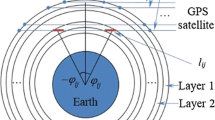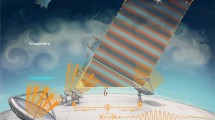Abstract
In 1994, Hajj et al. (1994) proposed the use of radio occultation data in ionospheric imaging. The advantages gained by including this data source are examined in this paper. Many data sources including ground-based and satellite-based observations are available for the events of the April 2002 ionospheric disturbance. This period has been chosen to study simultaneous images of the disturbed ionosphere over the USA and Europe. A 4D tomographic imaging technique known as Multi-instrument Data Analysis System (MIDAS) (Mitchell and Spencer, 2003) is applied in this study. The primary purpose of the study is to compare images produced with and without the use of radio-occultation data. The work investigates whether GPS occultation combined with ground-based GPS data improves the determination of peak height and peak density in the images. The results indicate that the occultation data improve both the peak height and the peak density in the images. The use of ionosonde data is also examined and the results are compared between the USA and Europe.






Similar content being viewed by others
References
Fremouw EJ, Secan JA, Howe BM (1992) Application of stochastic inverse theory to ionospheric tomography. Radio Science 27(5):721–732
Hajj GA, Ibańez-Meier R, Kursinski ER, Romans LJ (1994) Imaging the ionosphere with the Global Positioning System. Int J Imag Syst Technol 5:174
Jakowski N, Wehrenpfennig A, Herse S, Reigber C, Luhr H, Grunwaldt L, Meehan TK (2002) GPS radio occultation measurements of the ionosphere from CHAMP: Early results. Geophys Res Lett 29(10):1457
Menke W (1989) Geophysical Data Analysis: Discrete Inverse Theory. Academic Press
Mitchell CN (2002) Combining radio-occultation measurements with other instruments to map the ionospheric electron concentration, In: First CHAMP Science Meeting. Potsdam, Germany, pp. 491–499
Mitchell CN, Spencer PSJ (2002) Development of tomographic techniques for large-scale ionospheric imaging. In: Proc of Ionospheric Effects Symposium. Alexandria, VA, pp. 6A1-1–6A1-8
Mitchell CN, Spencer PSJ (2003) A three-dimensional time-dependent algorithm for ionospheric imaging using GPS. Ann Geophys 46(4):678–696
Reigber Ch, Luhr H, Schwintzer P (2000) CHAMP mission status and perspectives. Suppl to EOS Transactions 81(48):F307
Rius A, Ruffini G, Cucurull L (1997) Improving the vertical resolution of ionospheric tomography with GPS occultations. Geophys Res Lett 24(18):2291–2294
Schreiner SW, Sokolovskiy SV, Rocken C, Hunt DC (1999) Analysis and validation of GPS/MET radio occultation data in the ionosphere. Radio Science 34(4):949–966
Acknowledgements
We are grateful to the UK PPARC and EPSRC for the sponsorship, SPIDR for the ionosonde data, and ISDC GFZ for the CHAMP measurements. Also we appreciate the use of GPS data from the IGS.
Author information
Authors and Affiliations
Corresponding author
Rights and permissions
About this article
Cite this article
Yin, P., Mitchell, C.N. Use of radio-occultation data for ionospheric imaging during the April 2002 disturbances. GPS Solut 9, 156–163 (2005). https://doi.org/10.1007/s10291-005-0143-9
Received:
Accepted:
Published:
Issue Date:
DOI: https://doi.org/10.1007/s10291-005-0143-9




